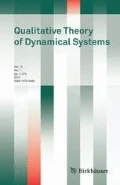1 Correction to: Qual. Theory Dyn. Syst. (2013) 12:293–303 https://doi.org/10.1007/s12346-012-0084-y
The final part of the proof of Lemma 2.7 in [3] is not correct as pointed out in [1]. The correct part, after Eq. (12), is the following one.
Suppose that \(r_5 \ne (0, 0)\). Then, from Eq. (12), we have \(d_6^3 \lambda + M = 0\), which is equivalent to
where \(R=d_6^{-3}\), for every mass \(m_5\). The last equation can be written as
which is equivalent to
Separating \(m_5\) in the last equation, we have
In the last equation, the factor multiplying \(m_5\) is null, then we get
which is equivalent to
Note that the quotient in the last equation is the Lagrange multiplier of the four co-circular bodies divided by \(\mathcal {M}=m_1+m_2+m_3+m_4\). Let \(\lambda _4\) be this Lagrange multiplier. So the last equation can be written as
Since the four co-circular bodies are in a convex central configuration with positions disposed counterclockwise, the following inequalities must hold (see for instance [2] p. 349)
On the other hand, using the perpendicular bisector theorem, we see that in a co-circular central configuration the center of the circle belongs to the interior of the convex hull of the quadrilateral, see [2]. Thus, from the geometry of a quadrilateral inscribed in the circle of radius \(d_6\) with the center of the circle inside the convex hull of the quadrilateral, at least one side is greater than \(\sqrt{2}d_6\). Thus, Eq. (13) is never satisfied, because the four co-circular bodies are in a convex central configuration. Therefore, in order to satisfy (12) we must have \(r_5=(0,0)=\mathcal {C}\) and the proof is complete.
References
Chen, K.C., Hsiao, J.S.: Strictly convex central configurations of the planar five-body problem. Trans. Am. Math. Soc. 370, 1907–1924 (2018)
Cors, J.M., Roberts, G.: Four-body co-circular central configurations. Nonlinearity 25, 343–370 (2012)
Fernandes, A.C., Mello, L.F.: On stacked planar central configurations with five bodies when one body is removed. Qual. Theory Dyn. Syst. 12, 293–303 (2013)
Author information
Authors and Affiliations
Corresponding author
Rights and permissions
About this article
Cite this article
Fernandes, A.C., Mello, L.F. Correction to: On Stacked Planar Central Configurations with Five Bodies when One Body is Removed. Qual. Theory Dyn. Syst. 18, 739–740 (2019). https://doi.org/10.1007/s12346-018-0280-5
Published:
Issue Date:
DOI: https://doi.org/10.1007/s12346-018-0280-5

